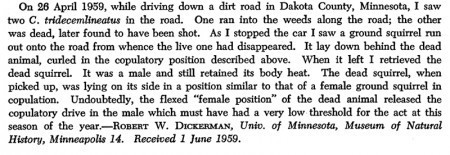Marc Abrahams's Blog, page 332
April 30, 2015
How much energy is there in all the excess human fat in the USA?
This paper, about the amount of energy contained in fat people in the USA, can fuel a new level of contentiousness in the nation’s ongoing, highly opinionated debates about energy policy, and perhaps about other things:
“How much energy is locked in the USA? Alternative metrics for characterising the magnitude of overweight and obesity derived from BRFSS 2010 data ,” Daniel D. Reidpath [pictured here], Mohd Masood, and Pascale Allotey, International Journal of Public Health, vol. 59, no. 3, 2014, pp. 503-507. (Thanks to Frédéric Darboux for bringing this to our attention.) The authors, at Monash University in, Selangor, Malaysia and the Universiti Teknologi MARA, Shah Alam, Malaysia, report:
,” Daniel D. Reidpath [pictured here], Mohd Masood, and Pascale Allotey, International Journal of Public Health, vol. 59, no. 3, 2014, pp. 503-507. (Thanks to Frédéric Darboux for bringing this to our attention.) The authors, at Monash University in, Selangor, Malaysia and the Universiti Teknologi MARA, Shah Alam, Malaysia, report:
“Methods: Behavioural Risk Factors Surveillance System data were used to estimate the weight the US population needed to lose to achieve a BMI\25. The metrics for population level overweight were total weight, total volume, total energy, and energy value.
“Results: About 144 million people in the US need to lose 2.4 million metric tonnes. The volume of fat is 2.6 billion litres—1,038 Olympic size swimming pools. The energy in the fat would power 90,000 households for a year and is worth around 162 million dollars….
“2.4 million metric tonnes of human lard, 1,038 olympic sized swimming pools of human tallow, enough human cellulite to power 90,000 homes for a year, or USD$162 million of human dripping seems to have all the makings for some very confronting ways of talking about a nation with a serious overweight and obesity problem. Whether they are useful for motivating policy changes with real impact is an empirical question that remains to be tested.”

“Finding a Mate With No Social Skills”
Computer scientists Chris Marriott of the University of Washington and Jobran Chebib of the University of Zürich recently posted a paper on the arXiv preprint server with the provocative title of “Finding a Mate With No Social Skills.”
Well, that title gives many of us a lot more hope, doesn’t it? In fact, there is a wonderful ambiguity in the article title: it can either refer to finding a mate without using any social skills or, more amusingly, to finding a mate who doesn’t have any social skills.
The authors seem to have the former meaning in mind. As they write in their abstract:
Sexual reproductive behavior has a necessary social coordination component as willing and capable partners must both be in the right place at the right time. While there are many known social behavioral adaptations to support solutions to this problem, we explore the possibility and likelihood of solutions that rely only on non-social mechanisms. We find three kinds of social organization that help solve this social coordination problem (herding, assortative mating, and natal philopatry) emerge in populations of simulated agents with no social mechanisms available to support these organizations. We conclude that the non-social origins of these social organizations around sexual reproduction may provide the environment for the development of social solutions to the same and different problems.
And just how do they quantify being in the right place at the right time? By finding each other at the same location of a random geometric graphs, of course. The idea behind using such a graph is to include effects from being embedded in space. (One places “nodes,” representing locations, using a random process and then connects pairs of locations to each other via “edges” if they are sufficiently close to each other.)

April 29, 2015
Podcast #9: Psychotic security guards
Psychotic security guards figure heavily in this week’s Improbable Research podcast.
LISTEN on Play.it or iTunes (or DOWNLOAD it, and listen later).
SUBSCRIBE on Play.it or iTunes, to get a new episode every week, free.
This week, Marc Abrahams tells about:
Psychotic security guards. (Silva, J. A., G. B. Leong, and R. Weinstock (1993). ‘The Psychotic Patient as Security Guard.’ Journal of Forensic Sciences 38 (6): 1436–40.)
Extracting the wrong tooth. (“The Case of the Wrong Tooth,” Laurance Jerrold and Mary Romeo, American Journal of Orthodontics and Dentofacial Orthopedics, vol. 100, no. 4, October 1991, pp. 376–81. / “Ethics Case Analysis: The Extraction of the Wrong Tooth,” Gary Chiodo, Susan Tolle, and Laurance Jerrold, American Journal of Orthodontics and Dentofacial Orthopedics, vol. 114, no. 6, 1998, pp. 721–3. / “Effectiveness of an Educational Program in Reducing the Incidence of Wrong-Site Tooth Extraction,” Hao-Hueng Chang, Jang-Jaer Lee, Shih-Jung Cheng, Puo-Jen Yang, Liang-Jiunn Hahn, Ying-Shiung Kuo, Wan-Hong Lan, and Sang-Heng Kok, Oral Surgery, Oral Medicine, Oral Pathology, Oral Radiology, and Endodontology, vol. 98, no. 3, 2004, pp. 288–94. / “Wrong Tooth Extraction: Root Cause Analysis,” Oren Peleg, Navot Givot, Tali Halamish-Shani, and Shlomo Taicher, Quintessence International, vol. 41, no. 10, November–December 2010, pp. 869–72. / “Experience of Wrong-Site Tooth Extraction Among Nigerian Dentists,” Wasiu L. Adeyemo, Olabisi H. Oderinu, Akanbi C.O. Olojede, Azeez A. Fashina., and Adeshina O.S. Ayodele, Saudi Dental Journal, vol. 23, no. 3, 2011, pp.153–6.)
Journeys of toothbrushes. (“The Swallowing of a Full-Sized Toothbrush: Report of a Case from the Los Angeles General Hospital,” C.A. Johnson, California and Western Medicine, vol. 26, no. 2, 1927, pp. 210. / “Toothbrush Swallowing,” Allan D. Kirk, Bert A. Bowers, Joseph A. Moylan, and William C. Meyers, Archives of Surgery, vol. 123, 1988, pp. 382–4. / “Inadvertent Swallowing of Toothbrush,” Dinesh Lal, New Zealand Medical Journal, vol. 123, no. 1321, 2010, pp. 69–70.)
Gravely mistaken. (Kelso, William M. (2006). Jamestown – The Buried Truth . Charlottesville: University of Virginia Press.)
Improbable medical review. (“The Tooth Fairy and Malpractice,” Sian Ludman, Hamid Daya, Polly S. Richards, and Adam Fox, BMJ, 2012, p. 345. / “The Odor Emitted From Dental Floss Used on Flossed and Non-Flossed Teeth for a One Week Time Period,” F.J. Ceravolo and A. Baumhammers, Periodontal Abstracts, vol. 21, no. 4, Winter 1973, pp. 155–8. / “Toothpick Perforation of a Colon Diverticulum: An Adjunct Autopsy Finding,” Glenn W. Wilcher, Medicine, Science and the Law, vol. 50, no. 3, July 2010, pp. 156–8. / “An Adventurous Habit of Bottle-Cap Opening Resulting in an Endodontic-Periodontal Lesion: A Case Report,” Deepa Ponnaiyan, K. Mahalinga Bhat, and G. Subraya Bhat, Quintessence International, vol. 40, no. 6, June 2009, pp. 449–51. / “Elevation of One Eye During Tooth Brushing,” Irene Gottlob, Sunila Jain, and Elizabeth C. Engle, American Journal of Ophthalmology, vol. 134, no. 3, September 2002, pp. 459–60. / “Extraction of a Grossly Decayed Tooth Without Local Anesthesia but with Audio Analgesia: A Case Report,” Manish Bhagania and Anirudha Agnihotry, Music and Medicine, vol. 3 no. 4, October 2011, pp. NP1–3.)
The Ham Sandwich Theorem. (Byrnes, Graham, Grant Cairns, and Barry Jessup (2001). ‘Leftovers from the Ham Sandwich Theorem.’ American Mathematical Monthly 108 (3): 246–49. / Beyer, W. A., and Andrew Zardecki (2004). ‘The Early History of the Ham Sandwich Theorem.’ American Mathematical Monthly 111 (1): 58–61.)
Improbable sex. (“Effects of Coitus on Nasal Temperature,” N.D. Fabricant, Fertility and Sterility, vol. 11, March 1960, pp. 195–19. / “Feelings of Regret Following Uncommitted Sexual Encounters in Canadian University Students,” Maryanne L. Fisher, Kerry Worth, Justin R. Garcia, and Tami Meredith, Culture, Health and Sexuality, vol. 14, no. 1, 2012, pp. 45-57. / “Postcoital Visual Loss Due to Valsalva Retinopathy,” Michaels, Luke, Naing Latt Tint, and Philip Alexander, BMJ Case Reports, epub October 23, 2014.)
Featuring dramatic readings by psychologist Jean Berko Gleason.
The mysterious John Schedler did the sound engineering this week.
The podcast is all about research that makes people LAUGH, then THINK — research about anything and everything, from everywhere —research that’s good or bad, important or trivial, valuable or worthless. CBS distributes it, both on the new CBS Play.it web site, and on iTunes.

Farewell, Robert W. Dickerman, the biologist who coined ‘Davian Behavior’
 Sad news. ‘Ornithology Exchange’ reported the death of Dr. Robert W. Dickerman (1926). Dickerman was the biologist who gave necrophilia a good name.
Sad news. ‘Ornithology Exchange’ reported the death of Dr. Robert W. Dickerman (1926). Dickerman was the biologist who gave necrophilia a good name.
Chiefly known as a specimen-based ornithologist and tireless collector of scientific specimens, Bob Dickerman has enriched the collections of natural history museums, from Alaska to New Mexico, and described dozens of new subspecies of mostly Mexican birds. He is depicted here with a Helmeted Guineafowl (in South Africa, 2011) that soon became specimen RWD #27413 in his personal catalogue.
As noted in a biographical sketch that introduced a special volume of Western Birds (43 [2012]) honoring his contribution to biology, Bob Dickerman had ‘… a naturalist’s eye and [was] keenly interested in the world around him’.
I did not know him personally, but we had a short and memorable e-mail correspondence about my Ig Nobel winning paper ‘The first case of homosexual necrophilia in the mallard’. He had noticed my paper, and responded to it on 23 March 2009:
” … neither you nor the “Board of Governors” at Harvard, knew of the very scattered, but plentiful, American literature on “Davian Behaviour”. The history of this behavior began when on 26 April 1959, I was driving down a dirt road [in Dakota County, Minnesota (KM)] , and stopped to look at a dead 13-striped ground squirrel (Citellus tridecimlineatus) lying dead in the middle of the road. As we stopped, another ran out from the side of the road and laid down and seemingly copulated with it! I published this observation in Journal of Mammalogy, naming it Davian Behavior. It became a “claus celebre” (spelling), and my next two notes [probably about the same subject (KM)] were rejected out-of-hand [because] two fellow graduate students sent the editor the limerick from which I got the name:
There was on old miser named Dave
who kept a dead whore in a cave.
He said “I’ll admit, I’m a bit of a shit”
but look at the money I save.”
Dr Dickerman was right. Back in 2001, I was unaware of both Dave (the old miser) and ‘Davian Behavior’ and so I completely missed two published cases of animal necrophilia – his own encounter with the 13-striped ground squirrel (published as “Davian Behavior Complex” in Ground Squirrels) – and even one involving a dead female mallard in Fort Collins, Colorado, witnessed and published (‘Avian Davian Behavior‘) by Philip N. Lehner in The Wilson Bulletin (1988).
Below is the most important part of his now classic ‘Davian Behavior’ paper:
By stressing the position of the dead ground squirrel, Bob Dickerman showed great insight in the true nature of this behavior and did not call it necrophilia.

Mancaves and masculinity
Man Caves. Are they retrograde expressions of masculine ethos, or therapeutic, integrative spaces? Either way, perhaps they haven’t received the academic attention they deserve? Until now. The Journal of Consumer Culture presents work by (California State University, Long Beach, USA) and Professor Mariam Beruchashvili (California State University, Northridge, USA) who have authored one of the only papers to have formally investigated Mancaves and masculinity.
“
[…] our study suggests that man caves play a pivotal yet a more complex role in men’s identity work at home than previously thought. Man caves are not just the retrograde expressions of masculine ethos premised on escaping the influence of the female and feminine domesticity. Rather, man caves emerge as therapeutic, integrative spaces. They operate as venues for weaving together the multiple aspects of men’s identities at times overwhelmed by professional and familial obligations. Man caves afford men a place for reinventing themselves as more fully functioning males integrated within the home, family, and the fraternity of other men.”
Also see: Bunkerology and The Testicular Fortitude of Urbexers
[Picture courtesy theogeo @ Wikipedia]

April 28, 2015
The Physics of Water-skipping Stones
In stone skipping, one tosses a stone with a flattened surface across water (or other fluid) to try to get it to bounce as many times as possible. (There are also military applications, but let’s stick to the fun stuff.)
A few months ago, mechanical engineer Tadd Truscott and collagues wrote a quick study on the physics of water-skipping stones (and spheres) in Physics Today. Among other things, they examined possible angles of attack and how they affect the subsequent skipping. The series of images below comes from this article.

Bonus: This is far from Truscott’s first improbable study of splashing. For example, he has also studied splash damage in urination.

April 27, 2015
The Fuzzification of Candlesticks
Having difficulty predicting the ups and downs of the stock market? Have you considered the fuzzification of candlesticks? Authors Partha Roy, Sanjay Sharma and M.K. Kowar (at the Bhilai Institute of Technology, Durg, India) have – and present their approach in the International Journal of Hybrid Information Technology, Vol. 5, No. 3, July, 2012.
The team’s fuzzification technique, which looks at the bullish and bearish aspects of both black and white fuzzified candlesticks is described on page 4 [of the pdf] of their paper ‘Fuzzy Candlestick Approach to Trade S&P CNX NIFTY 50 Index using Engulfing Patterns’
“Human brain creates rules through experience and uses it at appropriate instances, similarly for our system, at every phase we develop Fuzzy-Rules. The accumulated Fuzzy-Rules from every phase would become the Fuzzy Rule-base. This Fuzzy-Rule-base guides the system and helps to decide the course of action whether to buy or sell.”
The team go on to explain that there is room for further work, possibly including, but not limited to, defuzzification of trend values towards crispness.

April 26, 2015
Trojan Butterflies
The name is alcon. Maculinea alcon.
Like a suave British superspy, or maybe even a trojan horse or the proverbial cute abandoned baby left on a doorstep, some butterfly larvae mimic the chemicals of ants to get worker ants to bring them home to the nest.
But that’s not all: as Francesca Barbero and Luca Pietro Casacci discuss in their recent quick study in Physics Today, the adoptees also trick their foster parents with sound. After arriving in their adopted home, the trojan butterflies start mimicking the sounds of ants too. One type (M. alcon) mimics the queen in order to get the royal treatment (e.g., they are fed in preference to the ant larvae). Another (M. teleius) lays low until it becomes a beautiful butterfly, and it then starts eating the ant brood.
Bonus (not terribly related): In the song Puss ‘n Boots by Adam Ant, the main character goes to London and becomes the queen.

April 25, 2015
“Can’t get enough of the poo”
The University of the Watwatersrand writes, on its web site:
Can’t get enough of the poo
BY ERNA VAN WYK
24 April 2015
“Tonight you will hear about small animals that play around in poo.”
With this, Professor Marcus Byrne started off his inaugural lecture delivered in the Senate Room at Wits University on Tuesday, 14 April 2015, following his promotion last year to Personal Professor in Zoology in the School of Animal, Plant and Environmental Sciences.
Thirty years ago he encountered this enigmatic insect that would “entertain” him, and in turn let him to entertain many others, in the name of science: the dung beetle.
It’s all about the poo
Since he joined Wits in 1987 Byrne had used dung beetles effectively as a vehicle to show evolution at its best. “It is a particularly good vehicle because of its relationship with poo,” Byrne chuckled. “It simply loves its poo and cannot get enough of it.”
“There are over 800 species in South Africa, 2 000 in Africa and 6 000 in the world. And only about 10% roll dung!” Byrne said….
Science makes up for our flaws
As a child growing up in the UK with its “limited fauna”, Byrne’s love for science was sparked by watching the great science communicator, David Attenborough, on television. In his own right, Byrne is an exceptional science communicator. His TEDx talk has attracted over 900 000 hits and with his team was awarded the 2013 Ig Nobel Prize for Astronomy and Biology….

April 24, 2015
WE WANT YOUR TECH ADVICE about the future of our magazine!
We beg your knowledgeable advice:
What is a good, reliable system to sell PDFs?
If you know, please tell us!
OUR MAGAZINE’S IMPROBABLE FUTURE: PDFs will replace paper.
 We are going to gradually (no rush!) phase out the paper version of the magazine — the Annals of Improbable Research — and phase in PDFs.
We are going to gradually (no rush!) phase out the paper version of the magazine — the Annals of Improbable Research — and phase in PDFs.
Our technical requirements are listed below.
We have so far identified only one promising system: Gumroad.
If you have experienced advice about Gumroad — or if you know of something else that’s good — please tell us. Please e-mail Marc Abrahams .
WHY WE ARE DOING THIS.
 We are good at producing a magazine full of research that makes people LAUGH then THINK. But we are tiny, and we are not very good at handling the maddening mechanics of paper subscriptions — dealing with the ever-increasing vaguaries, complexities and breakdowns of the world’s postal systems, subscription agencies, etc. — those things have been driving us (and some of you, our ever-patient, beloved subscribers) nuts.
We are good at producing a magazine full of research that makes people LAUGH then THINK. But we are tiny, and we are not very good at handling the maddening mechanics of paper subscriptions — dealing with the ever-increasing vaguaries, complexities and breakdowns of the world’s postal systems, subscription agencies, etc. — those things have been driving us (and some of you, our ever-patient, beloved subscribers) nuts.
WHAT THIS MEANS FOR EVERYONE.
The price of buying a year’s subscription will go way down. And(!) you will be able to easily, cheaply obtain any or all of the back issues. There are more than 120 back issues —six timelessly improbable issues from every year since 1995! See all of them, at <http://www.improbable.com/magazine/>
WHAT THIS MEANS FOR CURRENT SUBSCRIBERS.
We intend to keep producing the paper version for a while (maybe a year, maybe longer), while we find and test a truly good way to sell the PDF version. After we have a good PDF-sales system in place, and have seen that it really does work well, we will present some nice options to everyone who is subscribing to the paper version.
OUR TECHNICAL REQUIREMENTS.
Here’s what we want the PDF sales system to do.
1A. It should be EASY and QUICK for a customer to buy and download any ONE magazine issue.
1B. It should be EASY and QUICK for a customer to buy and download ALL the issues from a particular calendar year (1995 or 1996 or 1997… or 2014 or 2015).
2. We do NOT want to copy-protect the files.
3. We DO want each downloaded PDF to be “PDF stamped” (every page includes some text that identifies the person who bought it).
BACKGROUND: Things we have tried, that failed.
1. Amazon and iTunes.
Ideally, we would sell the PDFs through the two biggest, easy-to-use online stores: Amazon.com and iTunes.
But Amazon and iTunes refuse to sell PDFs.
Damn, damn, damn.
2. Ebooks (EPUB files).
We have tried selling EPUB versions of the magazine, on Amazon, iTunes, and elsewhere. But EPUBs and nicely formatted magazines, as a combination, are a complicated can-of-worms. Buy us a beer and we’ll tell you all about that. We might some day make additional EPUBs, but not in the very near future.
3. E-junkie.
We do now sell some back issues as PDFs, via E-junkie. E-junkie has its virtues, BUT… E-junkie does not have any good way to handle subscriptions.

Marc Abrahams's Blog
- Marc Abrahams's profile
- 14 followers






